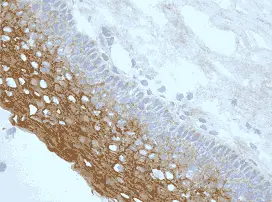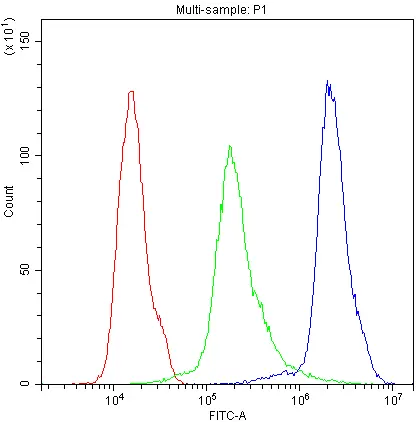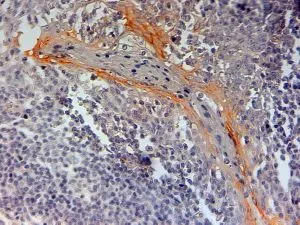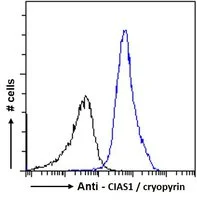
Staining of endogenous NLRP3/NALP3 in epithelial layer of human tonsil (frozen section) using NLRP3/NALP3 (human), mAb (Nalpy3-b)
NLRP3 antibody [nalpy3-b]
GTX17267
ApplicationsImmunoPrecipitation, Western Blot, ImmunoHistoChemistry, ImmunoHistoChemistry Frozen
Product group Antibodies
TargetNLRP3
Overview
- SupplierGeneTex
- Product NameNLRP3 antibody [nalpy3-b]
- Delivery Days Customer9
- Application Supplier NoteWB: 1:1,000. IP: 1:50. *Optimal dilutions/concentrations should be determined by the researcher.Not tested in other applications.
- ApplicationsImmunoPrecipitation, Western Blot, ImmunoHistoChemistry, ImmunoHistoChemistry Frozen
- CertificationResearch Use Only
- ClonalityMonoclonal
- Clone IDnalpy3-b
- ConjugateUnconjugated
- Gene ID114548
- Target nameNLRP3
- Target descriptionNLR family pyrin domain containing 3
- Target synonymsAGTAVPRL, AII, AVP, C1orf7, CIAS1, CLR1.1, DFNA34, FCAS, FCAS1, FCU, KEFH, MWS, NALP3, PYPAF1, NACHT, LRR and PYD domains-containing protein 3, NACHT domain-, leucine-rich repeat-, and PYD-containing protein 3, NACHT, LRR and PYD containing protein 3, PYRIN-containing APAF1-like protein 1, caterpiller protein 1.1, cold autoinflammatory syndrome 1 protein, cold-induced autoinflammatory syndrome 1 protein, cryopyrin, cryopyrin, NACHT, LRR and PYD domains - containing protein 3, deafness, autosomal dominant 34, nucleotide-binding oligomerization domain, leucine rich repeat and pyrin domain containing 3
- HostMouse
- IsotypeIgG1
- Protein IDQ96P20
- Protein NameNACHT, LRR and PYD domains-containing protein 3
- Scientific DescriptionThis gene encodes a pyrin-like protein containing a pyrin domain, a nucleotide-binding site (NBS) domain, and a leucine-rich repeat (LRR) motif. This protein interacts with the apoptosis-associated speck-like protein PYCARD/ASC, which contains a caspase recruitment domain, and is a member of the NALP3 inflammasome complex. This complex functions as an upstream activator of NF-kappaB signaling, and it plays a role in the regulation of inflammation, the immune response, and apoptosis. Mutations in this gene are associated with familial cold autoinflammatory syndrome (FCAS), Muckle-Wells syndrome (MWS), chronic infantile neurological cutaneous and articular (CINCA) syndrome, and neonatal-onset multisystem inflammatory disease (NOMID). Multiple alternatively spliced transcript variants encoding distinct isoforms have been identified for this gene. Alternative 5 UTR structures are suggested by available data; however, insufficient evidence is available to determine if all of the represented 5 UTR splice patterns are biologically valid. [provided by RefSeq, Oct 2008]
- Storage Instruction2°C to 8°C
- UNSPSC12352203








